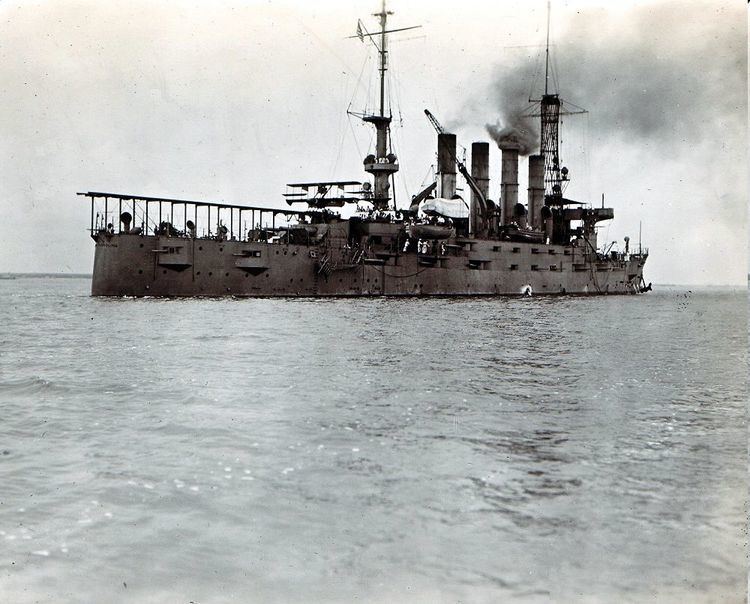Name North Carolina Awarded 3 January 1905 Construction started 21 March 1905 Builder Newport News Shipbuilding | Ordered 27 April 1904 Laid down 21 March 1905 Launched 6 October 1906 | |
 | ||
Namesake State of North Carolina
City of Charlotte, North Carolina Cost $3,575,000 (contract price of hull and machinery) | ||
USS North Carolina (ACR-12/CA-12) was a Tennessee-class armored cruiser of the United States Navy and the second Navy ship so named. She was also known as "Armored Cruiser No. 12" and later renamed and reclassified Charlotte (CA-12).
Contents
She was laid down on 21 March 1905 by Newport News Shipbuilding and Dry Dock Co., Newport News, Virginia, launched on 6 October 1906, sponsored by Miss Rebekah Glenn, daughter of the Governor of North Carolina R. B. Glenn, and commissioned at Norfolk on 7 May 1908, Captain William A. Marshall in command.
Pre-World War I
Following shakedown along the eastern seaboard and in the Caribbean, North Carolina carried President-elect William Howard Taft on an inspection tour to the Panama Canal in January–February 1909. From 23 April – 3 August, the new cruiser cruised the Mediterranean. Sailing with Montana to protect Americans threatened by conflict in the Ottoman Empire. North Carolina sent a medical relief party ashore on 17 May to Adana, Turkey, to treat both wounded and desperately ill Armenians, victims of massacre. North Carolina provided food, shelter, disinfectants, distilled water, dressings and medicines, and assisted other relief agencies already on the scene. For the remainder of her Mediterranean cruise, North Carolina cruised the Levant succoring both American citizens and refugees from oppression.
In the years before World War I, North Carolina trained and maneuvered in the western Atlantic and Caribbean and participated in ceremonial and diplomatic activities. Highlights included attending centennial celebrations of the independence of Argentina (May–June 1910) and Venezuela (June–July 1911); carrying the Secretary of War for an inspection tour of Puerto Rico, Santo Domingo, Cuba, and the Panama Canal (July–August 1911); and bringing home from Cuba bodies of the crew of the destroyed Maine for their final interment in Arlington National Cemetery.
World War I
As war began in Europe, North Carolina departed Boston on 7 August 1914 to protect Americans in the Near East by helping them evacuate and return to the United States. She rendezvoused with the USS Tennessee off Cape Cod before crossing the Atlantic. After calling at ports of England and France, she cruised constantly between Jaffa, Beirut, and Alexandria, her presence a reminder of the might of still neutral America. She returned to Boston on 18 June for overhaul.
Pensacola, Florida on 9 September, North Carolina contributed to the development of naval aviation through service as station ship. On 5 November, she became the first ship ever to launch an aircraft (a Curtiss Model AB-2) by catapult while under way, flown by Captain Henry C. Mustin, Navy Air Pilot No.3, and Naval Aviator No. 11. This experimental work led to the use of catapults on battleships and cruisers through World War II, and to the steam catapults on present-day aircraft carriers.
When the U.S. entered the war, North Carolina sailed north to escort troop transports plying between Norfolk and New York.
Inter-war period
From December 1918 – July 1919, she brought men of the American Expeditionary Force home from Europe. Renamed Charlotte on 7 June 1920 so that her original name might be assigned to a new battleship, she decommissioned at Puget Sound Navy Yard, Bremerton, Washington on 18 February 1921. Her name was struck from the Naval Vessel Register on 15 July 1930, and she was sold for scrapping on 29 September.
